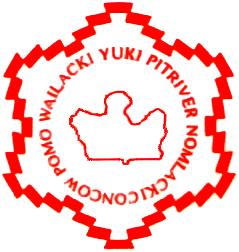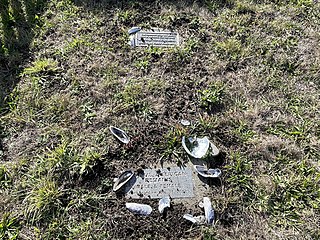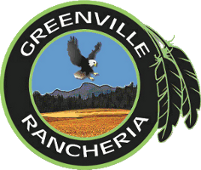
Greenville is an unincorporated community in Plumas County, California, United States, on the north-west side of Indian Valley. Most of the buildings were destroyed by the Dixie Fire in August 2021. The population was 1,129 at the 2010 census, down from 1,160 at the 2000 census. For statistical purposes, the United States Census Bureau has defined Greenville as a census-designated place (CDP). According to the Census Bureau, the CDP has a total area of 8.0 square miles (21 km2), all of it land.
The Shingle Springs Band of Miwok Indians, Shingle Springs Rancheria, California is a federally recognized tribe.
The Federated Indians of Graton Rancheria, formerly known as the Federated Coast Miwok, is a federally recognized American Indian tribe of Coast Miwok and Southern Pomo Indians. The tribe was officially restored to federal recognition in 2000 by the U.S. government pursuant to the Graton Rancheria Restoration Act.

The Mechoopda are a tribe of Maidu people, an Indigenous people of California. They are enrolled in the Mechoopda Indian Tribe of Chico Rancheria, a federally recognized tribe. Historically, the tribe has spoken Konkow, a language related to the Maidu language, and as of 2010, has created digital learning materials from old recordings of Emma Cooper, made during the 1940s as a part of the war effort.

The Round Valley Indian Reservation is a federally recognized Indian reservation lying primarily in northern Mendocino County, California, United States. A small part of it extends northward into southern Trinity County. The total land area, including off-reservation trust land, is 93.939 km2. More than two-thirds of this area is off-reservation trust land, including about 405 acres (1.64 km2) in the community of Covelo. The total resident population as of the 2000 census was 300 persons, of whom 99 lived in Covelo.

The United Auburn Indian Community (UAIC) is a federally recognized Native America tribe consisting mostly of Miwok Indians indigenous to the Sacramento Valley region.
Indian termination describes United States policies relating to Native Americans from the mid-1940s to the mid-1960s. It was shaped by a series of laws and practices with the intent of assimilating Native Americans into mainstream American society. Cultural assimilation of Native Americans was not new; the belief that indigenous people should abandon their traditional lives and become what the government considers "civilized" had been the basis of policy for centuries. What was new, however, was the sense of urgency that, with or without consent, tribes must be terminated and begin to live "as Americans." To that end, Congress set about ending the special relationship between tribes and the federal government.
The Berry Creek Rancheria of Maidu Indians of California are a federally recognized Native American tribe based in northeastern California, south of Lassen Peak. They historically have spoken the Konkow language, also known as Northeastern Maidu.
The Big Sandy Rancheria of Mono Indians of California is a ranchería and federally recognized tribe of Western Mono Indians (Monache) located in Fresno County, California, United States. As of the 2010 Census the population was 118. In 1909, the Bureau of Indian Affairs (BIA) bought 280 acres (110 ha) of land for the Big Sandy Band of Western Mono Indians.

The Sherwood Valley Rancheria of Pomo Indians of California is a federally recognized tribe of Pomo Indians in California.
The Scotts Valley Band of Pomo Indians of California, also known as the Scott's Valley Band of Pomo Indians of the Sugar Bowl Rancheria is a federally recognized tribe of Pomo and Wailaki Indians in Lake County.

The Robinson Rancheria of Pomo Indians of California is a federally recognized tribe of Eastern Pomo people in Lake County, California.

Wilton Rancheria is a federally recognized Native American tribe of Miwok people based in northern California. They were formed from Wilton Rancheria Miwok and the Me-Wuk Indian Community of the Wilton Rancheria. It regained recognition in 2009.
The Susanville Indian Rancheria is a federally recognized ranchería of Native Americans in northeastern California whose people are from the Washoe, Achomawi, Mountain Maidu, Northern Paiute, and Atsugewi tribes.

The Mooretown Rancheria of Maidu Indians of California is a federally recognized tribe of Concow and Maidu people in Butte County. Concow, or Konkow, people are the northwestern or foothill branch of the Maidu people, who traditionally spoke the Concow language

The Picayune Rancheria of Chukchansi Indians of California is a federally recognized tribe of indigenous people of California, affiliated with the Chukchansi subgroup of the Foothills Yokuts. The Picayune Rancheria, founded in 1912 and located in Coarsegold, California, covers 160 acres (1 km2) in Madera County and serves as the tribal land.

The Paskenta Band of Nomlaki Indians, or in their own language Nomlāqa Bōda, is a federally recognized tribe of Nomlaki people. The Nomlaki are Central Wintun, or River and Hill Nomlaki, an indigenous people of California, located in Tehama and Glenn counties.
The California Rancheria Termination Acts refer to three acts of Congress and an amendment passed in the 1950s and 1960s as part of the US Indian termination policy. The three Acts, passed in 1956, 1957, and 1958 targeted 41 Rancherias for termination. An additional seven were added via an amendment in 1964. Including three previous terminations, 46 of the 51 targeted Rancherias were successfully terminated. Through litigation and legislation, over 30 Rancherias have been restored and at least five are still working to be.
The Nevada City Rancheria was the federally recognized land and name of the Nisenan Native American people in Northern California. The Rancheria land was obtained in 1887 by Tribal Chief Charley Cully. When he died in 1911, the land allotment was converted by an executive order of President Woodrow Wilson into the Nevada City Rancheria.











